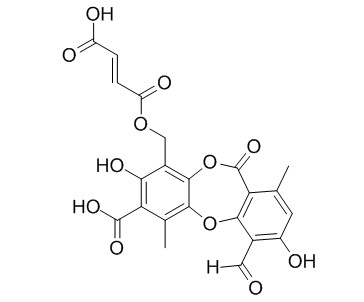Fumarprotocetraric acid
Fumarprotocetraric acid has expectorant, antioxidant, antimicrobial , and allelopathic properties. It shows inhibitory activity against enzymes such as tyrosinase, a key agent in melanin biosynthesis.
Inquire / Order:
manager@chemfaces.com
Technical Inquiries:
service@chemfaces.com
Tel:
+86-27-84237783
Fax:
+86-27-84254680
Address:
1 Building, No. 83, CheCheng Rd., Wuhan Economic and Technological Development Zone, Wuhan, Hubei 430056, PRC
Providing storage is as stated on the product vial and the vial is kept tightly sealed, the product can be stored for up to
24 months(2-8C).
Wherever possible, you should prepare and use solutions on the same day. However, if you need to make up stock solutions in advance, we recommend that you store the solution as aliquots in tightly sealed vials at -20C. Generally, these will be useable for up to two weeks. Before use, and prior to opening the vial we recommend that you allow your product to equilibrate to room temperature for at least 1 hour.
Need more advice on solubility, usage and handling? Please email to: service@chemfaces.com
The packaging of the product may have turned upside down during transportation, resulting in the natural compounds adhering to the neck or cap of the vial. take the vial out of its packaging and gently shake to let the compounds fall to the bottom of the vial. for liquid products, centrifuge at 200-500 RPM to gather the liquid at the bottom of the vial. try to avoid loss or contamination during handling.
Appl. Sci.2021, 11(24),12080
Natural Product Communications2020, doi: 10.1177.
Metabolites2022, 12(6),507.
Molecules2022, 27(12):3903.
Molecules.2022, 27(7):2116.
American Association for Anatomy2020, doi: 10.1002.
Sci Rep. 2024, 14(1):70.
Nat Prod Commun.2018, 10.1177
Onco Targets Ther.2017, 10:3467-3474
Planta Med.2023, 2192-2281
Related and Featured Products
Tropical Bryology,1999,17:133-139.
Allelopathic effect of the Cladonia verticillaris lichen extracts and fumarprotocetraric acid on the early growth of germinated seedlings in Allium cepa L.[Reference:
WebLink]
METHODS AND RESULTS:
The allelopathic activity of the different type of Cladonia verticillaris lichen extracts and Fumarprotocetraric acid on the early growth of A. cepa (IPA 6) germinated seedlings depends on their chemical composition and concentration, respectively. It was observed that the length of the radicle was significantly stimulated by Fumarprotocetraric acid at high concentrations and by the total extract of C. verticillaris thalli, which contained high level of fumarprotocetraric, acid confirmed by HPLC – technique. In addition, it was found, that the phosphate buffer extract, which contained high level of methy b-orcinol carboxilate measured by HPLC, significantly reduced the length of the hypocotyls. Under our experimental conditions there was no influence of different type of extract and Fumarprotocetraric acid on the seed germination ratio of A. cepa, in relation to control.
CONCLUSIONS:
From the study of HPLC it was found that Fumarprotocetraric acid and methy b-orcinol carboxilate were present in all extracts at different concentrations, according to the method of extraction.
The Electronic Journal of Chemistry,2017,9(4).
Effects of Fumarprotocetraric Acid, a Depsidone from the Lichen Cladonia verticillaris, on Tyrosinase Activity.[Reference:
WebLink]
Lichens are widely distributed around the world. Their phenolic compounds, consisting mainly of depsides and depsidones, have been extensively studied for important biological activities. More recently, these compounds have been evaluated for their inhibitory activity against enzymes such as tyrosinase, a key agent in melanin biosynthesis.
METHODS AND RESULTS:
In the present investigation, the depsidone Fumarprotocetraric acid isolated from the lichen Cladonia verticillaris (Raddi) Fr. was evaluated for its inhibitory activity against this critical enzyme. Kinetic study showed that depsidone at 0.6 mM inhibited tyrosinase activity by 39.8%.
CONCLUSIONS:
Lineweaver–Burk plots revealed that Fumarprotocetraric acid can act as an uncompetitive or mixed-type inhibitor, depending on concentration.
Pulmonary Pharmacology & Therapeutics, 2014, 27(2):139-143.
Expectorant and antioxidant activities of purified fumarprotocetraric acid from Cladonia verticillaris lichen in mice.[Reference:
WebLink]
The lichen Cladonia verticillaris produces bioactive secondary metabolites, such as fumarprotocetraric (FUM) and protocetraric acids. Species of the genus Cladonia demonstrate anti-tumor, anti-inflammatory and antipyretic activities and have been used in folk medicine to treat respiratory diseases (throat irritation, cough, asthma and tuberculosis). The aim of the present study was to evaluate the expectorant and mucolytic activities of Fumarprotocetraric acid in albino Swiss mice.
METHODS AND RESULTS:
FUM was extracted and purified from an acetone extract of C. verticillaris. The phenol red quantification method was used on the bronchoalveolar lavage fluid following the administration of FUM (25, 50 or 100 mg/kg orally or intraduodenally and 12.5, 25 or 50 mg/kg, intraperitoneally) for the evaluation of expectorant activity. Control groups received either saline solution (7.5 mL/kg) or ambroxol (1 mg/kg) through the same administration routes. Antioxidant activity was evaluated using the thiobarbituric acid reactive species assay in mouse lung tissue treated with the FUM at 25, 50 or 100 mg/kg orally, followed by a lipopolysaccharide solution at 1 mg/kg intrapleurally. The same protocol was used for the control groups using either saline solution (7.5 mL/kg, orally) or N-acetylcysteine (20 mg/kg, orally). Results: Orally administered FUM at doses of 25 and 50 mg/kg promoted significantly greater dose-dependent phenol red activity in the bronchoalveolar lavage and expectorant activity in comparison to the controls (p < 0.05). Lipid peroxidation (malondialdehyde equivalent) was reduced by 50% in the lung tissue.
CONCLUSIONS:
The results confirm the expectorant and antioxidant properties of Fumarprotocetraric acid produced by the lichen C. verticillaris.



